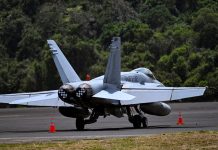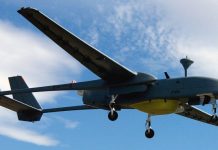Indonesia’s decision to strengthen ties with rival countries as part of its non-aligned strategy could have negative ramifications on its existing relationships. South Korean analysts, for one, have expressed concerns over Jakarta’s renewed ties with North Korea and a potential threat to the KF-21 ‘Boramae’ program.
Indonesia’s Foreign Minister Sugiono visited Pyongyang in North Korea on 11 October 2025, at the invitation of North Korean Foreign Minister Choe Son Hui.
The two leaders renewed a Memorandum of Understanding (MoU) for a bilateral consultation mechanism, which has been described as a platform to explore cooperation across political, socio-cultural, technical, and sports sectors.
At a time when China, Russia, and North Korea are creating a closer axis of cooperation, Indonesia is believed to be establishing itself as a middle power that can interact with all parties without sacrificing its independence, the Lowy Institute said in a recent article.
However, South Korea may not be as comfortable with this new lease of life injected into the Indonesia-North Korea relationship.
Some observers in Seoul have noted that a potential defense agreement between the two sides could compromise sensitive technology related to the KF-21 4.5th-generation fighter jet program, which South Korea and Indonesia jointly developing.
The Defense Acquisition Program Administration (DAPA) reportedly dismissed all concerns and rumours, stating that the nondisclosure agreement with Indonesia protects the KF-21 technology.
“We do not believe KF-21 technology will be leaked. We strictly limit access to technology transfers to approved end users and will ensure it cannot be compromised,” DAPA chief Seok Jong-gun said on October 17.
Despite that, critics remain unconvinced due to Indonesia’s track record on the collaborative project, which includes payment delays and leak scandals, as reported by The Korea Times, which cited experts.
Indonesia initially pledged to cover 20% of the program’s estimated cost of 8.1 trillion won, or about $5.9 billion, in exchange for 48 aircraft to be constructed through technology transfer. However, due to financial difficulties exacerbated by the COVID-19 pandemic and its aftermath, payments were repeatedly delayed.

Frustrated by these delays, South Korea at one point even considered going it alone in the program, before it agreed to reduce Indonesia’s contribution to 7.5% earlier this year.
Tensions peaked last year when South Korea accused Indonesian engineers participating in the development of the KF-21 Boramae fighter jet of allegedly stealing technologies associated with the project. The accused engineers were caught attempting to remove a USB flash drive containing classified KF-21 data from a production facility.
Observers have apparently called for preventive measures after Indonesia and North Korea renewed diplomatic ties, stating that Pyongyang has long aspired to acquire South Korea’s sophisticated defense technologies.
“Indonesia has long had weaknesses in managing sensitive information, and these structural issues have caused several disruptions in the KF-21 project,” said Yang Uk, a military expert and research fellow at the Asan Institute for Policy Studies, told the Korea Times.
Last year, the South Korean Police revealed that three North Korean hacking gangs reportedly broke into roughly ten domestic defense companies to obtain military data over the course of 18 months.
Additionally, some observers have stated that South Korea is not the only country with concerns about technological security because the KF-21 program is also using US technology.
Though the KF-21 is equipped with a majority of local components, the aircraft is powered by the F414 engines that are built under license from US firm GE Aerospace.
It is pertinent to note here that these are mere conjectures and do not reflect the position of the South Korean government, at least as of yet.
Indonesia’s Diverse Air Force
Indonesia’s quest for advanced fighter jets has been marked by twists and turns, with shifting alliances, procurement plans, and financial hurdles defining the nation’s defense acquisition strategy.
Nevertheless, the country continues to forge ahead with its modernisation plans, marked by new and unexpected purchases. It states that the pragmatic, non-aligned defense strategy reflected in Indonesia’s procurement plan provides the country with considerable flexibility to seek military agreements with a variety of partners.
For instance, Indonesia’s Defense Minister, Sjafrie Sjamsoeddin, recently announced that the country could acquire J-10 fighter jets from China. ”They will be flying over Jakarta soon,” Sjamsoeddin stated, without disclosing more specific details. The disclosure came months after the Indonesian Deputy Defense Minister Donny Ermawan Taufanto announced that China had offered the J-10C jets to the country.
Some leading media publications state that the Southeast Asian country would buy 42 J-10C fighter jets, while others have noted that it is interested in second-hand J-10B variants of the multi-role aircraft. A contract is yet to be signed.

Whatever the choice eventually is, the acquisition would be the first time that Indonesia buys a Chinese fighter jet.
Interestingly, the Defense Minister’s comments came months after the country signed a deal for the acquisition of 48 Turkish KAAN fifth-generation fighter jets on June 11, becoming the first-ever foreign customer of the aircraft.
The contract, valued at $10 billion, reportedly includes the production and delivery of the KAAN fighter jets to Indonesia over ten years, according to Turkish media. Additionally, the deal includes a technology transfer to Indonesia, as previously reported by the EurAsian Times.
Just one day after the KAAN deal in June 2025, Indonesia signed a strategic cooperation agreement with Korean Aerospace Industries (KAI). The move, as per analysts, demonstrates the country’s commitment to the KF-21 project. Jakarta has been a collaborative partner on the South Korean KF-21 supersonic fighter jet since 2015.

Most importantly, though, Indonesia made its most significant purchase in 2022 when it signed a US$8.1 billion defense deal with France, which included 42 Rafale fighter jets.
Indonesia could acquire an additional batch of Rafales from France after Indonesia signed a letter of intent expressing its intention to acquire additional Rafale fighter jets from Dassault Aviation.
The country already operates the Russian Su-30 aircraft and Su-27 fighter jets, and has confirmed that talks for the purchase of Su-35 are largely intact.
In addition to these, it also signed a memorandum of understanding with Boeing in 2022 to acquire up to 24 F-15EX fighters. According to recent reports, the government has not abandoned the planned F-15EX purchase, despite ongoing questions about the $8 billion price tag for just two dozen fighter jets.
If Indonesia proceeds with all plans, it could operate a very diverse fleet of American, Russian, French, Korean, Turkish, and Chinese fighter jets.
While this approach stems from a desire to avoid over-reliance on any single supplier and is rooted in historical arms embargoes from the West as well as threats of sanctions, it has drawn criticism from defense experts.
The diversity is seen as “bad news” because it exposes a fragmented, reactive defense strategy that undermines operational effectiveness, inflates costs, and risks Indonesia’s broader geopolitical ambitions.
Among the biggest disadvantages is the incompatibility of systems from competing vendors. All these aircraft have disparate avionics, armament systems, and communication protocols. This could lead to “serious interoperability challenges,” which would make it hard for the fighters to communicate data in real-time, function smoothly in joint operations, or coordinate with other friendly military services.
For instance, cross-training pilots and integrating weapons from Western, Russian, and now Chinese ecosystems would be difficult to coordinate.
Additionally, it would be a logistical nightmare, as noted by several keen analysts. Maintaining a diverse fleet necessitates several parallel supply chains, each customized to use parts, equipment, and processes from different suppliers. This could potentially result in increased logistical effort to source and pay for spare parts and “non-standardized maintenance systems,” which would just increase operational responsibilities.
Beyond logistics, the overall financial impact would also likely be substantial. Additionally, experts believe that this fragmented procurement signals a lack of coherent doctrine and would end up resulting in “contradictory messages” to partners and straining relations with some key allies, like the US.
- Contact the author at sakshi.tiwari13 (at) outlook.com
- Follow EurAsian Times on Google News




